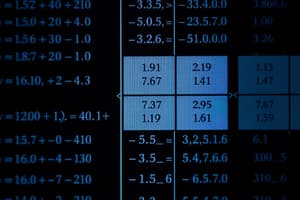Podcast
Questions and Answers
What does the slope (b) represent in the linear equation Y = a + bX?
What does the slope (b) represent in the linear equation Y = a + bX?
- The total value of the dependent variable when the independent variable is zero
- The amount by which the dependent variable changes for each unit increase in the independent variable (correct)
- The total number of units sold
- The starting point of the dependent variable
Which of the following is true about bivariate regression analysis?
Which of the following is true about bivariate regression analysis?
- It can be used with multiple dependent variables
- It determines causation between the variables
- It requires more than one independent variable
- It analyzes the relationship between one independent variable and one dependent variable (correct)
What is the primary purpose of multiple regression analysis?
What is the primary purpose of multiple regression analysis?
- To analyze the relationship between independent and dependent variables with only one independent variable
- To provide a correlation coefficient between a single independent variable and a dependent variable
- To establish a linear relationship between two variables only
- To analyze the relationship between two or more independent variables and a single dependent variable (correct)
What does regression analysis NOT imply about the relationship between X and Y?
What does regression analysis NOT imply about the relationship between X and Y?
In the regression line derived from least-squares estimation, what does the intercept (a) indicate?
In the regression line derived from least-squares estimation, what does the intercept (a) indicate?
What does the coefficient of price indicate in the energy drink sales regression analysis?
What does the coefficient of price indicate in the energy drink sales regression analysis?
What does an adjusted R-squared value of 0.59 represent in the regression analysis?
What does an adjusted R-squared value of 0.59 represent in the regression analysis?
In the regression equation for FastTransport Company, what does a coefficient of 21.46 for weight of the cargo (X2) signify?
In the regression equation for FastTransport Company, what does a coefficient of 21.46 for weight of the cargo (X2) signify?
What is indicated by the p-value of 0.0001 for price in the energy drink sales regression?
What is indicated by the p-value of 0.0001 for price in the energy drink sales regression?
What is the intercept in the FastTransport regression equation indicative of?
What is the intercept in the FastTransport regression equation indicative of?
What does the estimated intercept ($a$) represent in the multiple regression equation?
What does the estimated intercept ($a$) represent in the multiple regression equation?
Which of the following statements regarding the effect of advertising on sales is true?
Which of the following statements regarding the effect of advertising on sales is true?
What is indicated by a p-value of $b_1 = 0.08$ in the context of hypothesis testing?
What is indicated by a p-value of $b_1 = 0.08$ in the context of hypothesis testing?
What does an Adjusted $R^2$ value of 0.09 imply about the model's explanatory power?
What does an Adjusted $R^2$ value of 0.09 imply about the model's explanatory power?
Why does the coefficient of advertising in the energy drink sales analysis make sense?
Why does the coefficient of advertising in the energy drink sales analysis make sense?
What does the step of face validity in regression analysis assess?
What does the step of face validity in regression analysis assess?
What is indicated by the hypothesis $H_a$: at least one $b_i ≠ 0$?
What is indicated by the hypothesis $H_a$: at least one $b_i ≠ 0$?
In the given multiple regression model, if airtime increases by 1 unit, what change in the monthly phone bill is expected, holding data usage constant?
In the given multiple regression model, if airtime increases by 1 unit, what change in the monthly phone bill is expected, holding data usage constant?
What does a significant p-value for $b_2$ (< 0.000) suggest about data usage in the regression model?
What does a significant p-value for $b_2$ (< 0.000) suggest about data usage in the regression model?
What should be considered about the face validity of the estimated coefficients?
What should be considered about the face validity of the estimated coefficients?
Why is multiple regression analysis favored for modeling complex phenomena?
Why is multiple regression analysis favored for modeling complex phenomena?
What does the estimated intercept (𝑎ො) represent in the regression equation?
What does the estimated intercept (𝑎ො) represent in the regression equation?
What is the coefficient (𝑏) interpreting in the regression equation?
What is the coefficient (𝑏) interpreting in the regression equation?
If the p-value is greater than 0.05, what conclusion can be drawn regarding H0?
If the p-value is greater than 0.05, what conclusion can be drawn regarding H0?
What does an R² value of 0.015 indicate in this regression analysis?
What does an R² value of 0.015 indicate in this regression analysis?
In the provided regression equation, what is the effect of an increase in X (units sold) on Y (total salary)?
In the provided regression equation, what is the effect of an increase in X (units sold) on Y (total salary)?
What does the term 'e' represent in the regression equation?
What does the term 'e' represent in the regression equation?
What does the hypothesis H0: 𝑏 = 0 signify in regression analysis?
What does the hypothesis H0: 𝑏 = 0 signify in regression analysis?
In the context of the given regression analysis, which statement regarding face validity is true?
In the context of the given regression analysis, which statement regarding face validity is true?
If the coefficient for units sold is reported as 102.2, what does this suggest about commission earnings?
If the coefficient for units sold is reported as 102.2, what does this suggest about commission earnings?
Which of the following is TRUE regarding the statistical test in regression analysis?
Which of the following is TRUE regarding the statistical test in regression analysis?
Flashcards
Bivariate Regression
Bivariate Regression
Analyzes the relationship between one independent variable and one dependent variable.
Multiple Regression
Multiple Regression
Analyzes the relationship between multiple independent variables and one dependent variable.
Regression Analysis
Regression Analysis
A method to determine if a linear relationship exists between variables.
Independent Variable
Independent Variable
Signup and view all the flashcards
Dependent Variable
Dependent Variable
Signup and view all the flashcards
Simple Linear Regression
Simple Linear Regression
Signup and view all the flashcards
Dependent Variable (Y)
Dependent Variable (Y)
Signup and view all the flashcards
Independent Variable (X)
Independent Variable (X)
Signup and view all the flashcards
Intercept (a)
Intercept (a)
Signup and view all the flashcards
Slope (b)
Slope (b)
Signup and view all the flashcards
Hypothesis Testing (H0, Ha)
Hypothesis Testing (H0, Ha)
Signup and view all the flashcards
p-value
p-value
Signup and view all the flashcards
R-squared (R²)
R-squared (R²)
Signup and view all the flashcards
Error Term (e)
Error Term (e)
Signup and view all the flashcards
Regression Analysis
Regression Analysis
Signup and view all the flashcards
Multiple Regression
Multiple Regression
Signup and view all the flashcards
Dependent Variable
Dependent Variable
Signup and view all the flashcards
Independent Variable
Independent Variable
Signup and view all the flashcards
Multiple Regression Equation
Multiple Regression Equation
Signup and view all the flashcards
F-test in Multiple Regression
F-test in Multiple Regression
Signup and view all the flashcards
Coefficient of Determination (R-squared)
Coefficient of Determination (R-squared)
Signup and view all the flashcards
Adjusted R-squared
Adjusted R-squared
Signup and view all the flashcards
Interpreting Coefficients
Interpreting Coefficients
Signup and view all the flashcards
Regression Equation
Regression Equation
Signup and view all the flashcards
Intercept (a)
Intercept (a)
Signup and view all the flashcards
Coefficient (b)
Coefficient (b)
Signup and view all the flashcards
Positive Coefficient
Positive Coefficient
Signup and view all the flashcards
Negative Coefficient
Negative Coefficient
Signup and view all the flashcards
Adjusted R-squared
Adjusted R-squared
Signup and view all the flashcards
P-value (F-statistic)
P-value (F-statistic)
Signup and view all the flashcards
Face Validity
Face Validity
Signup and view all the flashcards
Study Notes
Course Information
- Course: Marketing Research
- Section: B
- Instructor: Dr. Yuyan Wei
- Term: Fall 2024
- Course Code: MARK 302
Chapter 14: Regression Analysis
- Topic: More powerful statistical methods
- Topic: Week 9
- Topic: Tests for relational hypothesis
- Topic: Regression analysis is used to analyze the relationship between variables
- Topic: Bivariate regression analyzes the relationship between one independent (predictor) and one dependent variable
- Topic: Multiple regression analyzes the relationship between two or more independent (predictor) variables and one dependent variable
- Topic: Regression analysis does not prove causation but can show correlation and relationships
Linear Relationship
- Description: A linear relationship exists when there's a consistent relationship between variables and they have a linear pattern
- Example: Salesperson's monthly salary = base salary + commission per unit sold, e.g., $2,500 + $100 x units sold
- Equation: Y = a + bX
- Y: dependent variable
- X: independent variable
- a: intercept (base salary)
- b: slope (commission)
Regression Line
- Description: The regression line is a straight line that best represents the relationship between independent and dependent variable in a scatterplot
- Equation: Y = a + bX + e
- Y: dependent variable
- â: estimated intercept
- b: estimated slope / coefficient
- X: independent variable
- e: error (difference between actual and predicted value)
Regression Analysis - Interpret Results
- Assumptions: b = 0 (no relationship vs. b ≠ 0 (relationship exists between variables)
- The simple regression statistical test produces p-value based on F-statistic for the hypothesis and estimates and intercepts
- R² / adjusted R²: measures percentage of variance in the dependent variable explained by the independent variable
- Significance level α (e.g., 0.1, 0.05, 0.01); if p-value ≤ α, reject null hypothesis
Interpreting Results – Face Validity
- Examine if the intercept and coefficients make sense in practice; are positive or negative coefficients meaningful for that context
In-Class Exercise #1
- Topic: Regression Analysis of Price and Advertising on Energy Drink Sales
- Steps to interpret Results
- Step 1: Use statistical equations to illustrate the relationship between variables
- Step 2: Check the P-value of F-stats
- Step 3: Check the P-value of t-stats
- Step 4: Interpret Adjusted R² (e.g., how much variation can be explained with the independent variables)
In-Class Exercise #2
- Topic: Regression Analysis of Transportation Costs for a Company
- Variables
- X₁: number of cargos per shipment
- X₂: weight of cargo
- Y: transportation costs
- Interpret a,b₁ and b₂
- Evaluate face validity in context (e.g. negative coefficient may seem counterintuitive; consider cost model elements that might cause regression to seem invalid)
Multiple Regression Analysis
- Equation: Y = a + b₁X₁ + b₂X₂ + … + bₙXₙ + e
- Y = dependent variable
- â = estimated intercept
- bᵢ= estimated slope / coefficient of
- Xᵢ = independent variables
- e = error term
- Hypotheses:
- H₀: No relationship between independent and dependent variables (b₁ = b₂= … = bₙ = 0)
- H₁: At least one independent variable affects the dependent variable (at least one bᵢ ≠ 0)
Multiple Regression Analysis - Interpret Results
- Describe how to interpret information from Excel outputs
- Step 1: Equation
- Step 2: Verify P-value (F-Stats). Verify statistical significance
- Step 3: Verify P-value of t-stats (individual variables). Determine whether a variable has a relationship with the dependent variable
- Step 4: Verify Adjusted R²
- Step 5: Check Face Validity (Examine the findings to make sense of the coefficients)
Studying That Suits You
Use AI to generate personalized quizzes and flashcards to suit your learning preferences.




